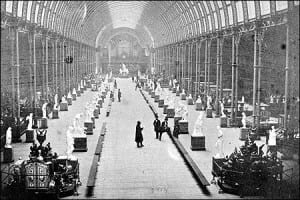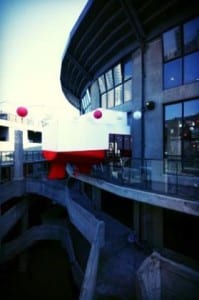1857: The Art Treasures Exhibition of Great Britain
Remaining the largest art exhibition to be held in the UK of all time is the Art Treasures Exhibition, held in Manchester, England from May to October 1857. This exhibition brought four times the population of Manchester, England, 1.3 million visitors, to view more than 16,000 works of art. A new railroad station was built to support these visitors, which included royalty, such as Prince Albert and Queen Victoria. Inspired by various European exhibitions, affluent businessmen financed the exhibition and hosted it in Old Trafford, which is now a football stadium but was previously used as a cricket ground. Contractors built a temporary venue, an iron-and-glass structure similar to the Crystal Palace, a host for early exhibitions in London. The hall of the venue included two public refreshment rooms and a royal reception room. At the end of the event, the financiers earned a small profit of £304, artists took home their art displays and the temporary building was demolished by the next year.
1891: The Great Exhibition of 1891 in Jamaica
 Planting the seed for the Great Exhibition of 1891 was A.C. Sinclair, a native Jamaican and a compiler of the annual Handbooks of Jamaica, who was inspired by the 1851 Great Exhibition at London’s Crystal Palace. To host the event, a Moorish architectural-style wooden exhibition building was built on the Kingston Race Course, which is now the site of National Heroes Park. More infrastructures were needed to support the event. Five hotels were built along with the improvement and construction of roads, bridges and railways. The opening day on Jan. 27, 1891 featured 8,000 people. Throughout its more than four-month run, the Great Exhibition consisted of flower shows, a fine arts gallery, plays and music. Boasting larger attendance records than earlier exhibitions in Europe and America, the major event received 302,831 visitors by the time it closed on May 2, 1891.
Planting the seed for the Great Exhibition of 1891 was A.C. Sinclair, a native Jamaican and a compiler of the annual Handbooks of Jamaica, who was inspired by the 1851 Great Exhibition at London’s Crystal Palace. To host the event, a Moorish architectural-style wooden exhibition building was built on the Kingston Race Course, which is now the site of National Heroes Park. More infrastructures were needed to support the event. Five hotels were built along with the improvement and construction of roads, bridges and railways. The opening day on Jan. 27, 1891 featured 8,000 people. Throughout its more than four-month run, the Great Exhibition consisted of flower shows, a fine arts gallery, plays and music. Boasting larger attendance records than earlier exhibitions in Europe and America, the major event received 302,831 visitors by the time it closed on May 2, 1891.
1933: The Shanghai Became the Only Art Deco Abattoir to Host Exhibitions
A building known as the 1933 Shanghai was first commissioned by the Shanghai Municipal Council, that same year, as an abattoir – a slaughterhouse. Prior to becoming the 1933 Shanghai, the building was used as a medicine factory and then a storage facility.  Once it entered its Shanghai phase, it held art galleries, design studios, and exhibitions and events. Built by Chinese developers and designed by British architects, the building is located in the northern Hongkou District of Shanghai, China. Here, visitors will find a structure unlike others as it is the last of its architectural kind. Designed with influences from the East and the West, the 1933 Shanghai also boasts Roman Basilica references. Truly illustrating the traditional Chinese Fengshui theory of a “round heaven encompassing of a square earth,” the structure features a round exterior contrasting a square interior.
Once it entered its Shanghai phase, it held art galleries, design studios, and exhibitions and events. Built by Chinese developers and designed by British architects, the building is located in the northern Hongkou District of Shanghai, China. Here, visitors will find a structure unlike others as it is the last of its architectural kind. Designed with influences from the East and the West, the 1933 Shanghai also boasts Roman Basilica references. Truly illustrating the traditional Chinese Fengshui theory of a “round heaven encompassing of a square earth,” the structure features a round exterior contrasting a square interior.
2004: Universal Forum of Cultures Featured Thematic Exhibitions
After failing to deliver on a 1996 international exposition for Barcelona, Spain, its city council, the regional government, the Spanish National Government and UNESCO organized the 2004 Universal Forum of Cultures from May to September. With the aim of supporting peace, sustainable development, human rights and respect for diversity, the Universal Forum hosted more than 40 international conventions, over 20 exhibitions, and activities and entertainment. Four thematic exhibitions were shown: Voices, which celebrated human communication and linguistic and cultural diversity; Inhabiting the World, a study on how humankind relates to the planet’s environment; Cities-Corners; a study on how cities are built; and Warriors of Xi’an, an exhibition of Chinese funerary art.
2005: Expo 2005 in Japan Went Green
Sustainability was practiced throughout Expo 2005, a World’s Fair held in Aichi Prefecture, Japan from March to September 2005. National and corporate pavilions highlighted ecological co-existence, renewable technology and nature to complement the Expo’s theme of Nature’s Wisdom. On 460 acres of forested land, the Expo featured pavilions made out of recycled or recyclable materials and provided environmentally friendly transportation. The Expo made a profit of more than 10 billion yen due to a visitor turnout of 22,049,544.






























